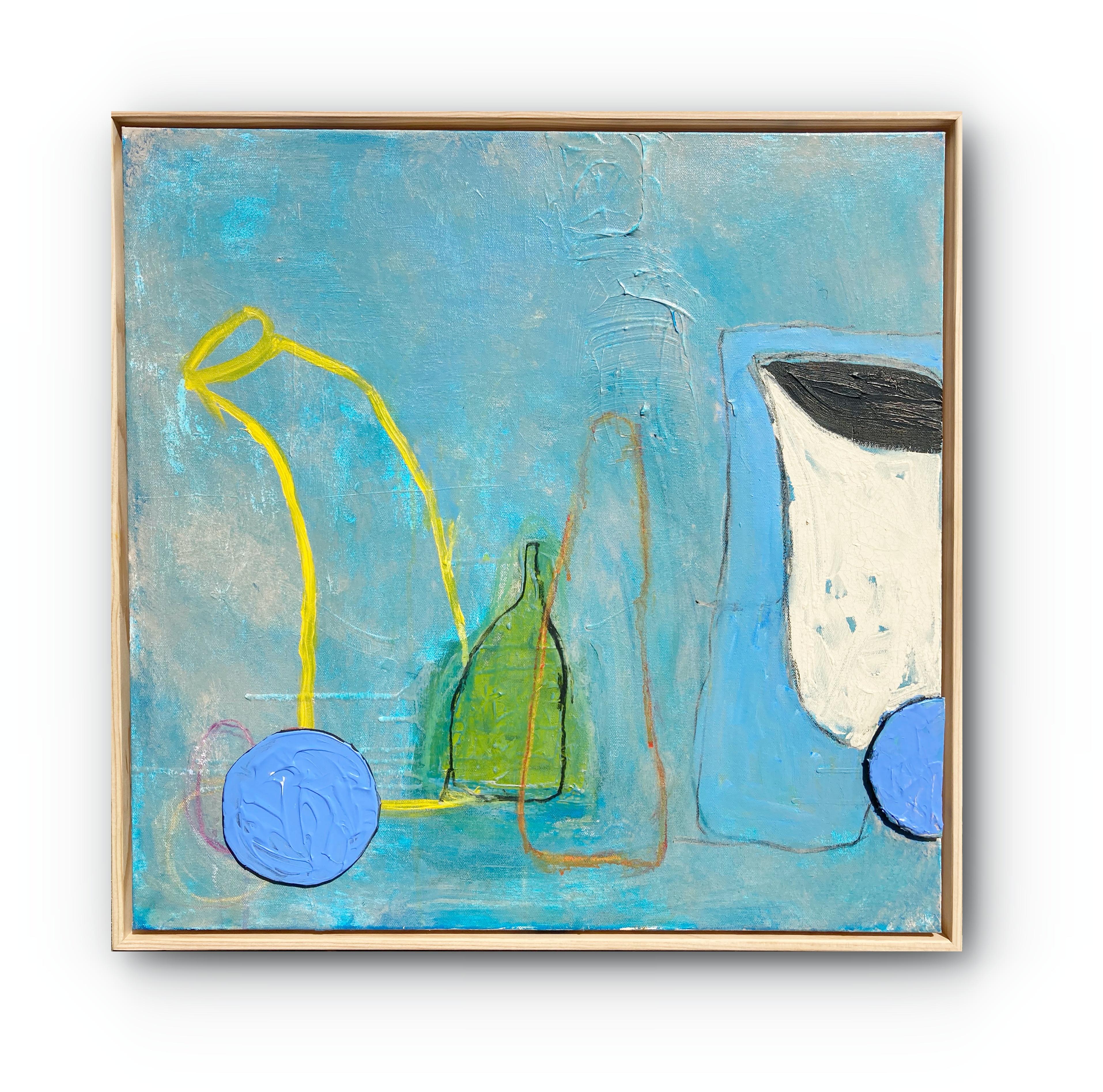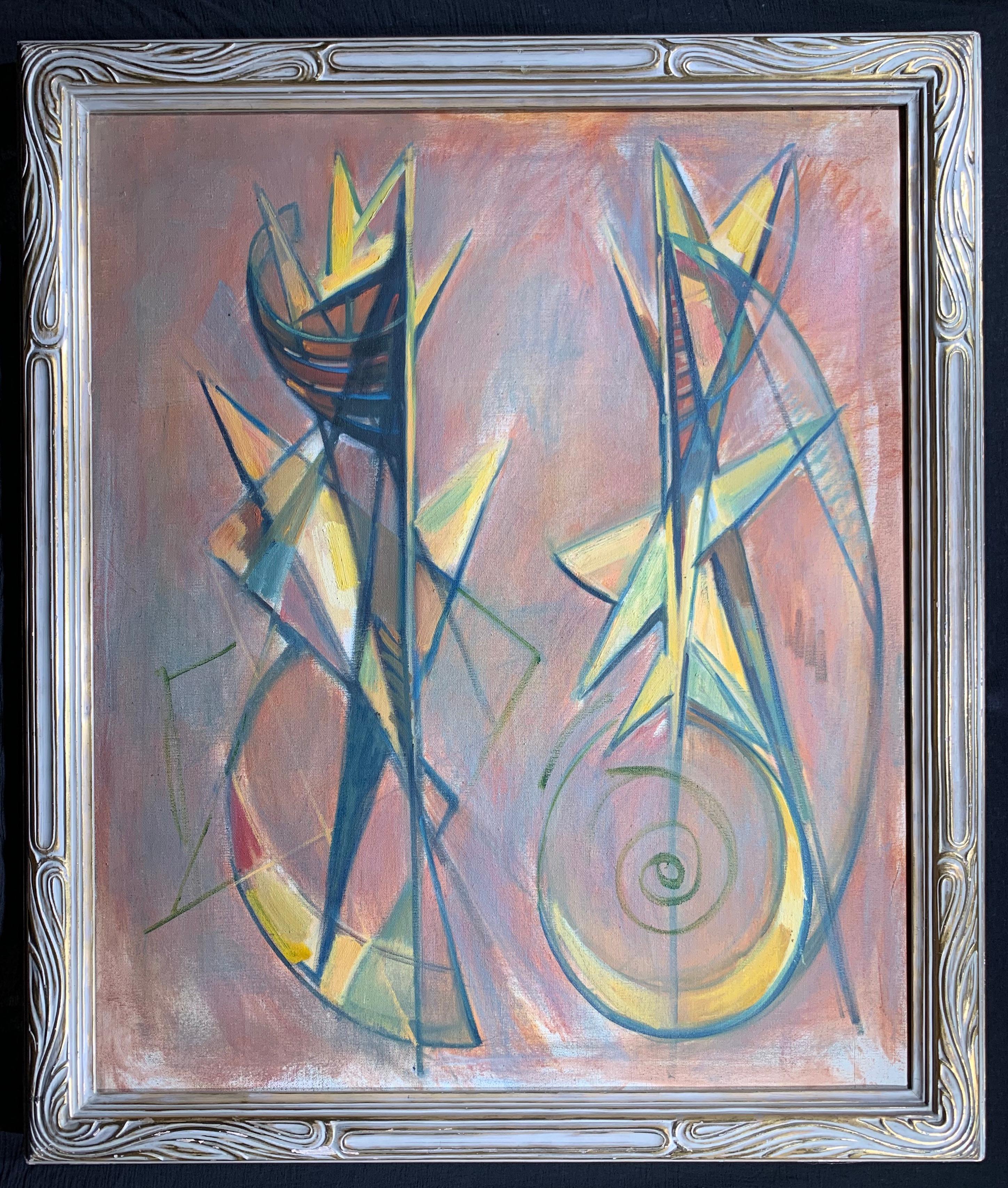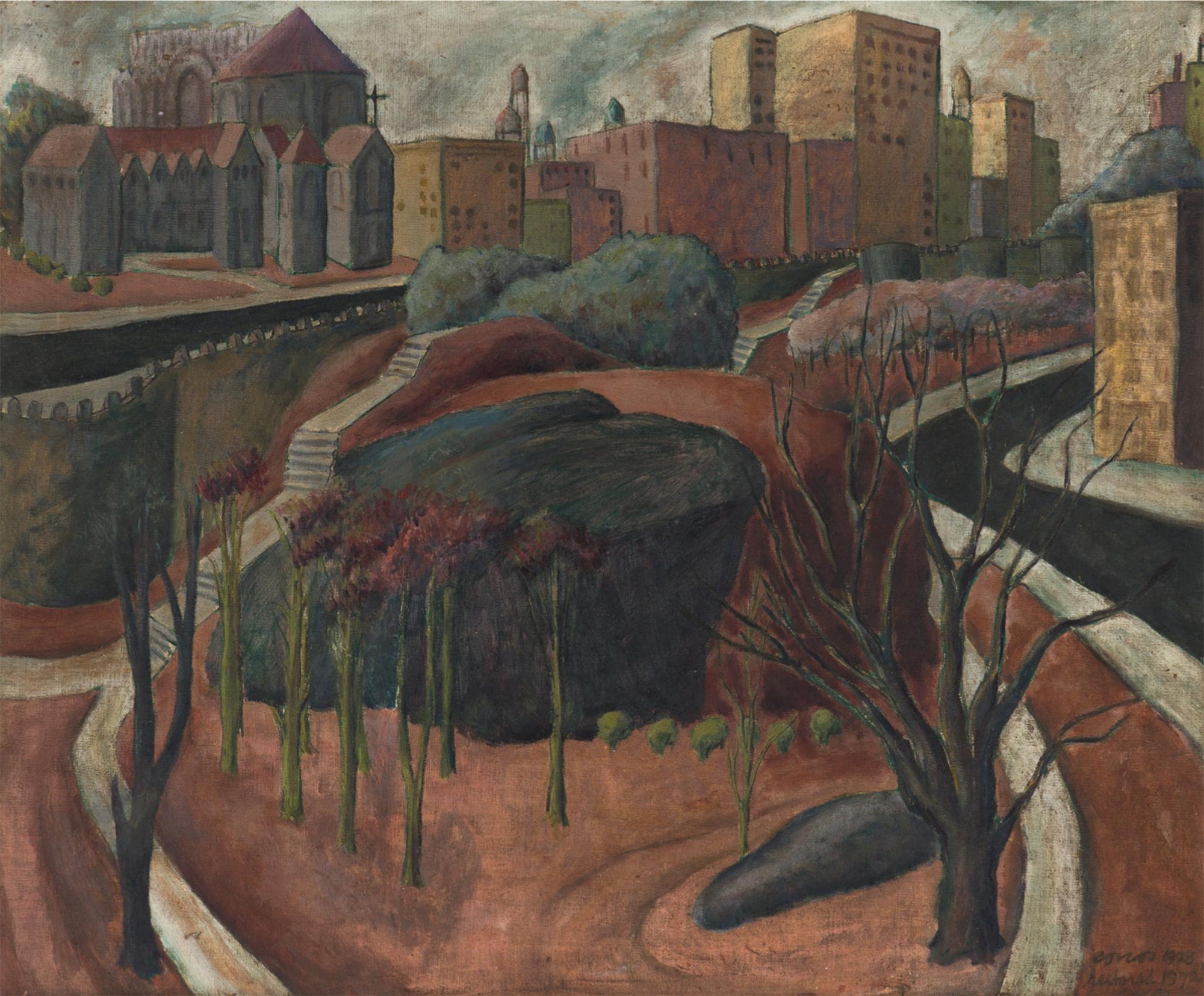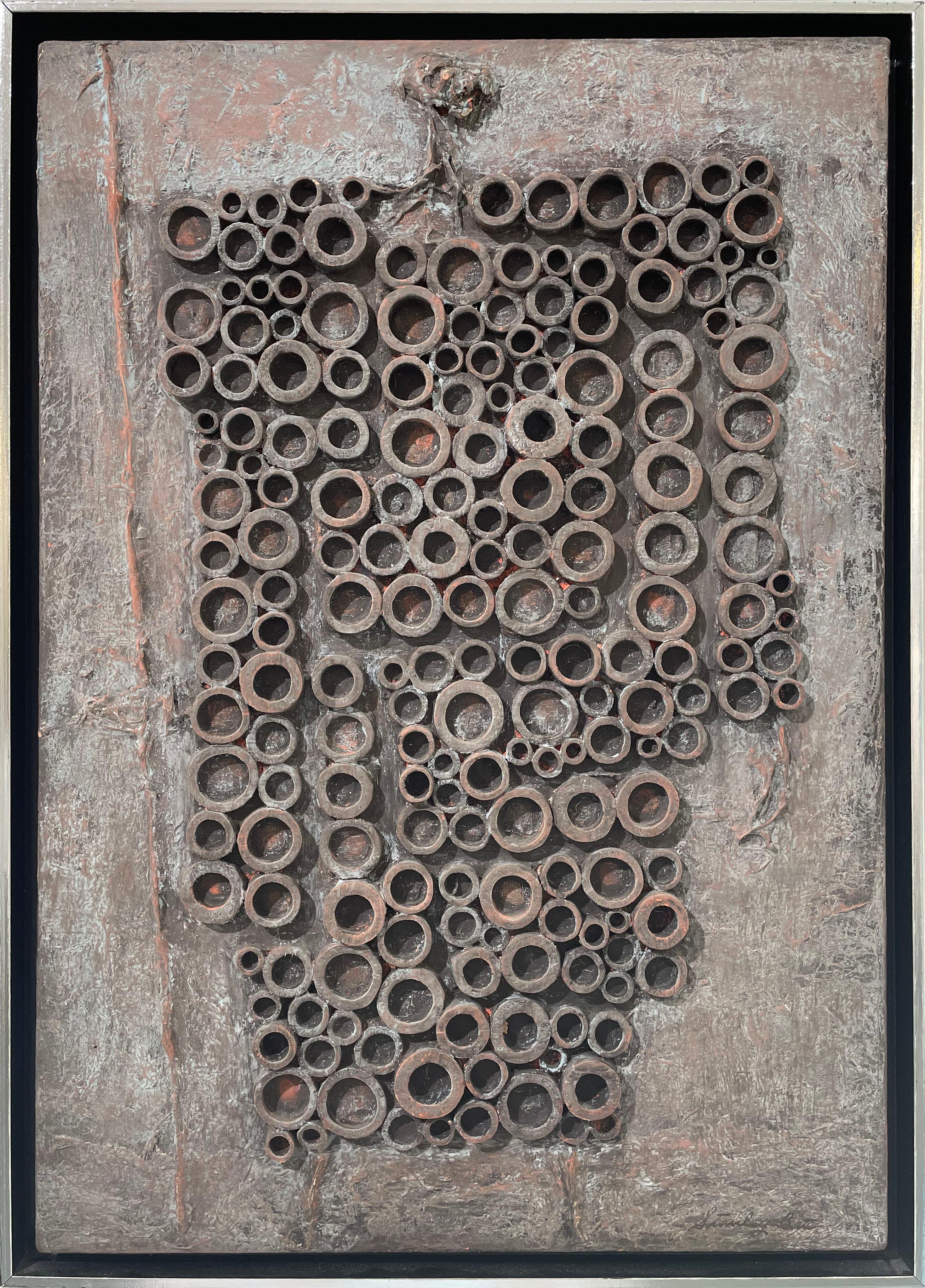Items Similar to Pyromaniac's Pyre mixed media work by Mary Spencer Nay
Want more images or videos?
Request additional images or videos from the seller
1 of 10
Mary Spencer NayPyromaniac's Pyre mixed media work by Mary Spencer Nay1974
1974
About the Item
Signed and dated "Mary Spencer Nay '74" lower left. Titled "Pyromaniac's Pyre" verso.
Exhibited:
1976-1977 "Mary Spencer Nay: Recent and Retrospective Works". J.B. Speed Art Museum, Louisville, KY. Catalogue #38, lent by Citizens Fidelity Bank and Trust Co.
Provenance: Ex collection Citizens Fidelity Bank & Trust Company, Louisville, KY
- Creator:Mary Spencer Nay (1913 - 1993, American)
- Creation Year:1974
- Dimensions:Height: 23.25 in (59.06 cm)Width: 31.5 in (80.01 cm)
- Medium:
- Movement & Style:
- Period:
- Condition:
- Gallery Location:Hudson, NY
- Reference Number:
About the Seller
5.0
Vetted Seller
These experienced sellers undergo a comprehensive evaluation by our team of in-house experts.
Established in 1973
1stDibs seller since 2023
5 sales on 1stDibs
Typical response time: <1 hour
- ShippingRetrieving quote...Ships From: Hudson, NY
- Return PolicyThis item cannot be returned.
More From This SellerView All
- Ceremonial Dancers oil and tempera painting by Julio De DiegoBy Julio de DiegoLocated in Hudson, NYArtwork measures 48" x 30" and framed 56 ¼" x 38 ¼" x 3" Provenance: John Heller Gallery, NYC, circa 1975 (label verso) The artist's daughter Corbino Galleries, Sarasota, FL (1990)...Category
1940s Modern Abstract Paintings
MaterialsMasonite, Oil, Tempera
- The Magician oil and tempera painting by Julio de DiegoBy Julio de DiegoLocated in Hudson, NYJulio De Diego’s Atomic Series paintings made an extraordinary statement regarding the shock and fear that accompanied the dawn of the nuclear age. In the artist’s own words, “Scientists were working secretly to develop formidable powers taken from the mysterious depths of the earth - with the power to make the earth useless! Then, the EXPLOSION! . . . we entered the Atomic Age, and from there the neo-Atomic war begins. Explosions fell everywhere and man kept on fighting, discovering he could fight without flesh.” To execute these works, De Diego developed a technique of using tempera underpainting before applying layer upon layer of pigmented oil glazes. The result is paintings with surfaces which were described as “bonelike” in quality. The forms seem to float freely, creating a three-dimensional visual effect. In the 1954 book The Modern Renaissance in American Art, author Ralph Pearson summarizes the series as “a fantastic interpretation of a weighty theme. Perhaps it is well to let fantasy and irony appear to lighten the devastating impact. By inverse action, they may in fact increase its weight.” Exhibited 1964 Marion Koogler McNay Art Institute, San Antonio, Texas This work retains its original frame which measures 54" x 42" x 2" About this artist: Julio De Diego crafted a formidable persona within the artistic developments and political struggles of his time. The artist characterized his own work as “lyrical,” explaining, “through the years, the surrealists, the social-conscious painters and the others tried to adopt me, but I went my own way, good, bad or indifferent.” [1] His independence manifested early in life when de Diego left his parent’s home in Madrid, Spain, in adolescence following his father’s attempts to curtail his artistic aspirations. At the age of fifteen he held his first exhibition, set up within a gambling casino. He managed to acquire an apprenticeship in a studio producing scenery for Madrid’s operas, but moved from behind the curtains to the stage, trying his hand at acting and performing as an extra in the Ballet Russes’ Petrouchka with Nijinsky. He spent several years in the Spanish army, including a six-month stretch in the Rif War of 1920 in Northern Africa. His artistic career pushed ahead as he set off for Paris and became familiar with modernism’s forays into abstraction, surrealism, and cubism. The artist arrived in the U.S. in 1924 and settled in Chicago two years later. He established himself with a commission for the decoration of two chapels in St. Gregory’s Church. He also worked in fashion illustration, designed magazine covers and developed a popular laundry bag for the Hotel Sherman. De Diego began exhibiting through the Art Institute of Chicago in 1929, and participated in the annual Chicago Artists Exhibitions, Annual American Exhibitions, and International Water Color Exhibitions. He held a solo exhibition at the Art Institute of Chicago in the summer of 1935. Though the artist’s career was advancing, his family life had deteriorated. In 1932 his first marriage dissolved, and the couple’s young daughter Kiriki was sent to live with friend Paul Hoffman. De Diego continued to develop his artistic vocabulary with a growing interest in Mexican art. He traveled throughout the country acquainting himself with the works of muralists such as Carlos Merida, and also began a collection of small native artifacts...Category
1940s American Modern Abstract Paintings
MaterialsMasonite, Oil, Tempera
- St. Atomic oil and tempera painting by Julio de DiegoBy Julio de DiegoLocated in Hudson, NYJulio De Diego’s Atomic Series paintings made an extraordinary statement regarding the shock and fear that accompanied the dawn of the nuclear age. In the artist’s own words, “Scientists were working secretly to develop formidable powers taken from the mysterious depths of the earth - with the power to make the earth useless! Then, the EXPLOSION! . . . we entered the Atomic Age, and from there the neo-Atomic war begins. Explosions fell everywhere and man kept on fighting, discovering he could fight without flesh.” To execute these works, De Diego developed a technique of using tempera underpainting before applying layer upon layer of pigmented oil glazes. The result is paintings with surfaces which were described as “bonelike” in quality. The forms seem to float freely, creating a three-dimensional visual effect. In the 1954 book The Modern Renaissance in American Art, author Ralph Pearson summarizes the series as “a fantastic interpretation of a weighty theme. Perhaps it is well to let fantasy and irony appear to lighten the devastating impact. By inverse action, they may in fact increase its weight.” Exhibited 1950 University of Illinois at Urbana "Contemporary American Painting" 1964 Marion Koogler McNay Art Institute, San Antonio, Texas This work retains its original frame which measures 54" x 36" x 2". About this artist: Julio De Diego crafted a formidable persona within the artistic developments and political struggles of his time. The artist characterized his own work as “lyrical,” explaining, “through the years, the surrealists, the social-conscious painters and the others tried to adopt me, but I went my own way, good, bad or indifferent.” [1] His independence manifested early in life when de Diego left his parent’s home in Madrid, Spain, in adolescence following his father’s attempts to curtail his artistic aspirations. At the age of fifteen he held his first exhibition, set up within a gambling casino. He managed to acquire an apprenticeship in a studio producing scenery for Madrid’s operas, but moved from behind the curtains to the stage, trying his hand at acting and performing as an extra in the Ballet Russes’ Petrouchka with Nijinsky. He spent several years in the Spanish army, including a six-month stretch in the Rif War of 1920 in Northern Africa. His artistic career pushed ahead as he set off for Paris and became familiar with modernism’s forays into abstraction, surrealism, and cubism. The artist arrived in the U.S. in 1924 and settled in Chicago two years later. He established himself with a commission for the decoration of two chapels in St. Gregory’s Church. He also worked in fashion illustration, designed magazine covers and developed a popular laundry bag for the Hotel Sherman. De Diego began exhibiting through the Art Institute of Chicago in 1929, and participated in the annual Chicago Artists Exhibitions, Annual American Exhibitions, and International Water Color Exhibitions. He held a solo exhibition at the Art Institute of Chicago in the summer of 1935. Though the artist’s career was advancing, his family life had deteriorated. In 1932 his first marriage dissolved, and the couple’s young daughter Kiriki was sent to live with friend Paul Hoffman. De Diego continued to develop his artistic vocabulary with a growing interest in Mexican art. He traveled throughout the country acquainting himself with the works of muralists such as Carlos Merida, and also began a collection of small native artifacts...Category
1940s American Modern Abstract Paintings
MaterialsMasonite, Oil, Tempera
- Inevitable Day – Birth of the Atom oil and tempera painting by Julio De DiegoBy Julio de DiegoLocated in Hudson, NYJulio De Diego’s Atomic Series paintings made an extraordinary statement regarding the shock and fear that accompanied the dawn of the nuclear age. In the artist’s own words, “Scientists were working secretly to develop formidable powers taken from the mysterious depths of the earth - with the power to make the earth useless! Then, the EXPLOSION! . . . we entered the Atomic Age, and from there the neo-Atomic war begins. Explosions fell everywhere and man kept on fighting, discovering he could fight without flesh.” To execute these works, De Diego developed a technique of using tempera underpainting before applying layer upon layer of pigmented oil glazes. The result is paintings with surfaces which were described as “bonelike” in quality. The forms seem to float freely, creating a three-dimensional visual effect. In the 1954 book The Modern Renaissance in American Art, author Ralph Pearson summarizes the series as “a fantastic interpretation of a weighty theme. Perhaps it is well to let fantasy and irony appear to lighten the devastating impact. By inverse action, they may in fact increase its weight.” Bibliography Art in America, April 1951, p.78 About this artists: Julio De Diego crafted a formidable persona within the artistic developments and political struggles of his time. The artist characterized his own work as “lyrical,” explaining, “through the years, the surrealists, the social-conscious painters and the others tried to adopt me, but I went my own way, good, bad or indifferent.” [1] His independence manifested early in life when de Diego left his parent’s home in Madrid, Spain, in adolescence following his father’s attempts to curtail his artistic aspirations. At the age of fifteen he held his first exhibition, set up within a gambling casino. He managed to acquire an apprenticeship in a studio producing scenery for Madrid’s operas, but moved from behind the curtains to the stage, trying his hand at acting and performing as an extra in the Ballet Russes’ Petrouchka with Nijinsky. He spent several years in the Spanish army, including a six-month stretch in the Rif War of 1920 in Northern Africa. His artistic career pushed ahead as he set off for Paris and became familiar with modernism’s forays into abstraction, surrealism, and cubism. The artist arrived in the U.S. in 1924 and settled in Chicago two years later. He established himself with a commission for the decoration of two chapels in St. Gregory’s Church. He also worked in fashion illustration, designed magazine covers and developed a popular laundry bag for the Hotel Sherman. De Diego began exhibiting through the Art Institute of Chicago in 1929, and participated in the annual Chicago Artists Exhibitions, Annual American Exhibitions, and International Water Color Exhibitions. He held a solo exhibition at the Art Institute of Chicago in the summer of 1935. Though the artist’s career was advancing, his family life had deteriorated. In 1932 his first marriage dissolved, and the couple’s young daughter Kiriki was sent to live with friend Paul Hoffman. De Diego continued to develop his artistic vocabulary with a growing interest in Mexican art. He traveled throughout the country acquainting himself with the works of muralists such as Carlos Merida, and also began a collection of small native artifacts...Category
1940s American Modern Abstract Paintings
MaterialsMasonite, Oil, Tempera
- #2 (5) Abstract Oil Painting by Max SchnitzlerLocated in Hudson, NYThis painting measures 55 ¾" x 35 ½" and framed 57" x 37" x 1". It is hand-signed "Schnitzler" on the lower right. About this artist: Max Schnitzler (1903-1999) emigrated with his ...Category
Mid-20th Century Abstract Expressionist Abstract Paintings
MaterialsCanvas, Oil
- Photography oil painting by Robert FreimarkBy Robert FreimarkLocated in Hudson, NYHand-signed and dated "Freimark 1963" lower right. Signed, titled and dated "Photography / pol. 1963 / Robert Freimark" verso. Provenance: -Gift from Robert Freimark to his friend T...Category
1960s Abstract Abstract Paintings
MaterialsCanvas, Oil
You May Also Like
- Petit Dejeuner (Framed Contemporary Abstract Painting)By Guy LymanLocated in New Orleans, LA"I have been painting seriously for somewhere around 35 years, but have only ever sold regionally - most recently, through my gallery on Magazine Street in New Orleans. Through 1stDi...Category
2010s Abstract Abstract Paintings
MaterialsRubber, Charcoal, Oil Crayon, Oil, Acrylic
- Large 1960 California "Abstract Landscape" Jack Stuck PaintingLocated in Arp, TXJack Stuck (1925-1993) "Abstract Landscape" 1960 Collage oil paint, charcoal, paper and canvas laid down on masonite 48"x46" natural wood frame 51" x 49" Si...Category
Mid-20th Century American Modern Abstract Paintings
MaterialsCanvas, Masonite, Charcoal, Oil, Laid Paper
- Newcomb Macklin antique carved custom gilt mirror/ picture frameLocated in Wilton Manors, FLAbstract painting, ca. 1970s measures 25 x 30 inches. Oil on canvas, unsigned. Stunning modernist custom carved picture frame by Newcomb Macklin. ca. 1950 production. Long, elegant...Category
Mid-20th Century American Modern Abstract Paintings
MaterialsCanvas, Wood, Oil
- Morningside Park, New York - Cathedral of St. John the DivineBy Lucille CorcosLocated in Miami, FLCorcos paints what appears to be the northern part Central Park from an elevated view looking northwest. The artist used a restricted palette of warm browns and grays with heavy outl...Category
1920s Modern Landscape Paintings
MaterialsCanvas, Masonite, Oil
- "Untitled #17 (Samurai), " 1960s Modern Abstract PaintingBy Stanley BateLocated in Westport, CTThis Modern Abstract Expressionist painting by Stanley Bate is made with oil paint and 3-dimensional wooden shapes on canvas. The warm metal grey paint is highly textured, while the ...Category
1960s Modern Abstract Paintings
MaterialsCanvas, Oil, Wood
- Abstract III (Abstract, Vibrant, Deep, Blue, Navy, Green, Orange, 30% OFF)By Jill OpelkaLocated in Kansas City, MOJill Opelka Abstract III Oil on Canvas Year: 2023 Size: 20x20in Framed: 21x21x1.5in Signed by hand COA provided Ref.: 924802-2050 Tags: Abstract, Vibrant, Deep, Blue, Navy, Green, Orange, Pink *Framed in a black wooden frame ----------------- Upon entering Jill Opelka's home, her creative essence is unmistakable. Adorned with New Yorker Magazine covers, her dining room exudes a vibrant charm, complemented by quirky giant tortoises in the living room. The space is a reflection of Opelka's lively personality, evident in her central studio nestled within the bright breakfast nook. Embraced by natural light and captivating outdoor vistas, it's where her artistry thrives, even evident in intricate details like a practical denim quilt...Category
2010s Modern Abstract Paintings
MaterialsCanvas, Wood, Oil




